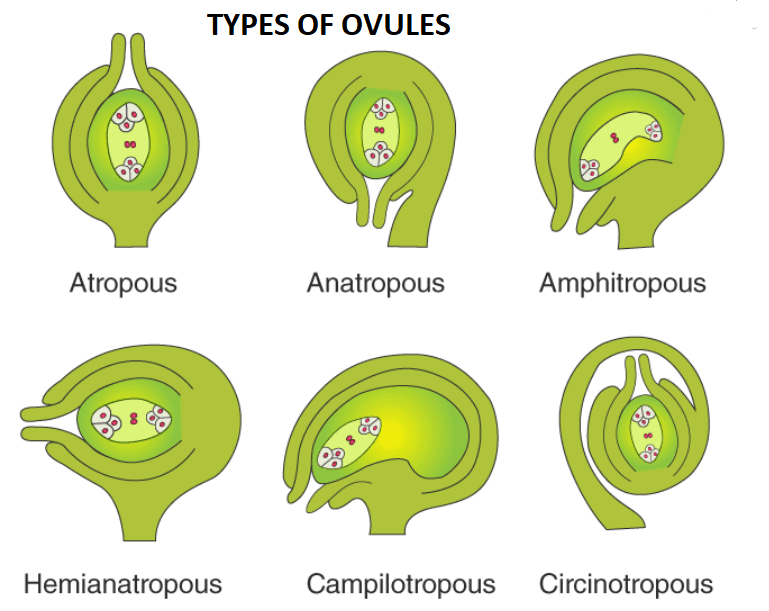
Describe types of ovules diagrammatically.
Answer
386.1k+ views
Hint: The ovule is a component of flowering plants that is found inside the gynoecium, which is the flower's female portion. Ovules in the ovary are found to be connected to the placenta by a stalk-like structure. After fertilisation, ovules become seeds.
The embryo sac is present in angiosperm, and after the fusing of the male gametes, it may result in endosperm, which ultimately feeds the children.
Complete answer:
Ovules can be generated in six different ways in Angiosperms. These are the
1. Orthotropous- The micropyle, chalaza, and funicle all lie in one straight line in an orthotropous ovule. Polygonaceae, Piperaceae, and most gymnosperm ovules are examples.
2. Anatropous (Inverted)- The ovule's body is entirely inverted, bringing the micropyle and hilum very close together. This form of ovule can be found in 82 percent of angiosperm families. Plants belonging to the gamopetalae sub-class are an example.
3. Campylotropous- The micropyle is oriented towards chalaza when the ovule is bent. Chalaza is perpendicular to the funicle. Members of the Cruciferae and Leguminosae families, for example.
4. Amphitropous or transverse ovule- The ovule curvature increases, and the embryo sac takes on a horseshoe form. Alismataceae and Butomaceae, for example.
5. Hemianatropous-When the nucellus and integuments are almost perpendicular to the funicle. For instance, the Ranunculaceae and Primulaceae families.
6. Circinotropous- Except for a small section at the end of the funicle, the funicle is extraordinarily lengthy and makes a complete circle around the ovules, which are free of it.Opuntia and other members of the Cactaceae and Plumbaginaceae families are examples.

Note:
The ovules of angiosperms, which are flowering plants, are covered. This stock, which is also known as the funicle or funiculus, connects the placenta of the overview to the placenta. The hilum is the point where the funiculus connects to the ovule's structure. The outer and inner into comment, as well as an embryo sac that is covered inside it, are all present. The nucellus is the part of the embryo sac that lies between the outer and inner integuments. Except for some of the higher sections, which are known as the micropyle, the integument covers the entire nucleus.
The embryo sac is present in angiosperm, and after the fusing of the male gametes, it may result in endosperm, which ultimately feeds the children.
Complete answer:
Ovules can be generated in six different ways in Angiosperms. These are the
1. Orthotropous- The micropyle, chalaza, and funicle all lie in one straight line in an orthotropous ovule. Polygonaceae, Piperaceae, and most gymnosperm ovules are examples.
2. Anatropous (Inverted)- The ovule's body is entirely inverted, bringing the micropyle and hilum very close together. This form of ovule can be found in 82 percent of angiosperm families. Plants belonging to the gamopetalae sub-class are an example.
3. Campylotropous- The micropyle is oriented towards chalaza when the ovule is bent. Chalaza is perpendicular to the funicle. Members of the Cruciferae and Leguminosae families, for example.
4. Amphitropous or transverse ovule- The ovule curvature increases, and the embryo sac takes on a horseshoe form. Alismataceae and Butomaceae, for example.
5. Hemianatropous-When the nucellus and integuments are almost perpendicular to the funicle. For instance, the Ranunculaceae and Primulaceae families.
6. Circinotropous- Except for a small section at the end of the funicle, the funicle is extraordinarily lengthy and makes a complete circle around the ovules, which are free of it.Opuntia and other members of the Cactaceae and Plumbaginaceae families are examples.

Note:
The ovules of angiosperms, which are flowering plants, are covered. This stock, which is also known as the funicle or funiculus, connects the placenta of the overview to the placenta. The hilum is the point where the funiculus connects to the ovule's structure. The outer and inner into comment, as well as an embryo sac that is covered inside it, are all present. The nucellus is the part of the embryo sac that lies between the outer and inner integuments. Except for some of the higher sections, which are known as the micropyle, the integument covers the entire nucleus.
Recently Updated Pages
Using the following information to help you answer class 12 chemistry CBSE

Full Form of IASDMIPSIFSIRSPOLICE class 7 social science CBSE

In case of conflict between fundamental rights of citizens class 7 social science CBSE

Can anyone list 10 advantages and disadvantages of friction

What are the Components of Financial System?

Complete the letter given below written to your Principal class null english null

Trending doubts
Show variation of resistivity of copper as a function class 12 physics CBSE

Electrolysis of dilute H2SO4 generates H2S2O8 What class 12 chemistry CBSE

Explain with a neat labelled diagram the TS of mammalian class 12 biology CBSE

How do you convert from joules to electron volts class 12 physics CBSE

A convex lens is placed in water Its focal length A class 12 physics CBSE

Distinguish between asexual and sexual reproduction class 12 biology CBSE




